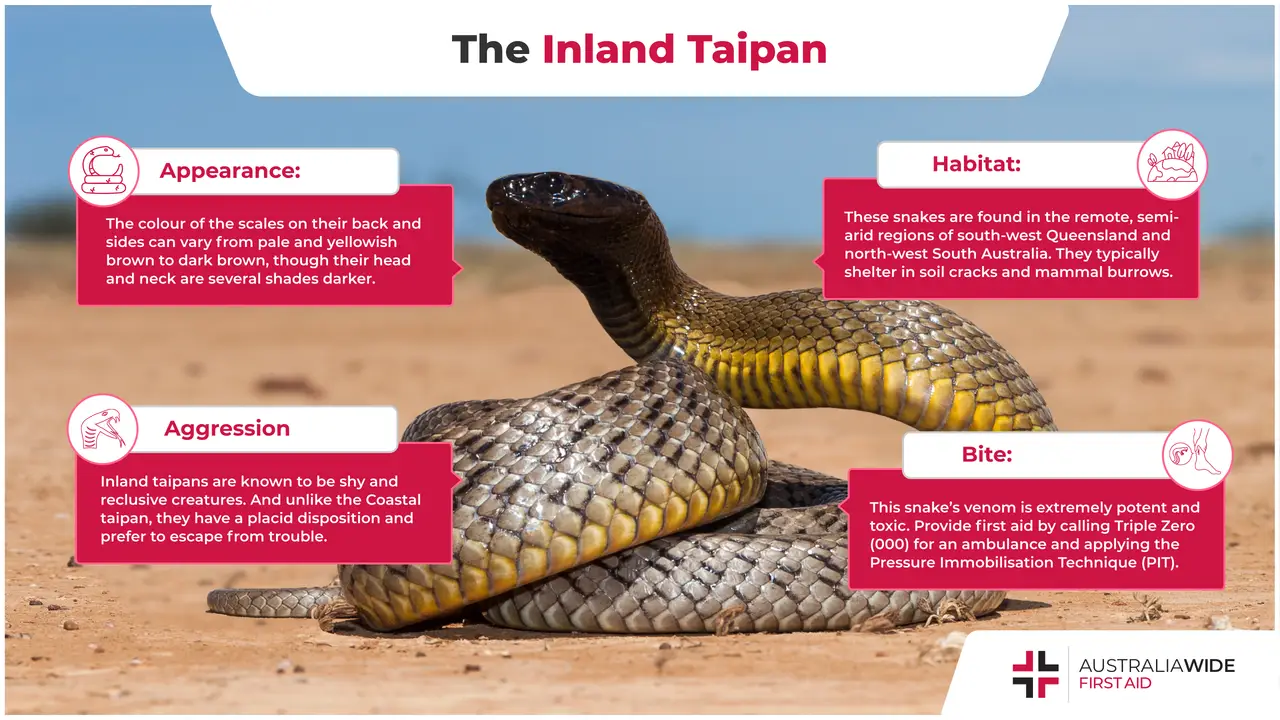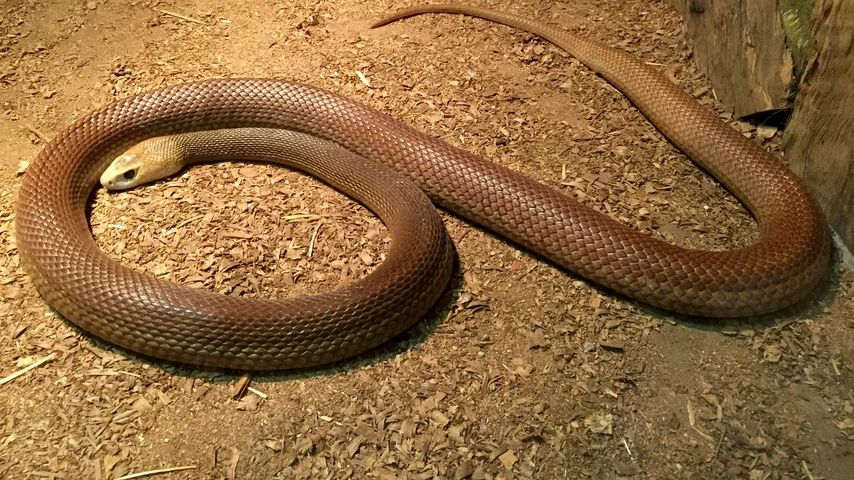Snake Facts: The Taipan


The Taipan is cited as one of the most dangerous snakes in Australia and around the world due to their aggressive behaviour and highly toxic bites.
There are two types of taipans found in Australia, namely, the Inland taipan and Coastal taipan. Both are known to be endemic to Australia and are listed within the top 5 most toxic snakes in the world.
Taipans are part of the Elapidae family first described by Wilhelm Peters in 1867. However, due to the rarity of Taipans, it wasn’t until the 1960s that these snakes began to be studied more closely by the scientific community. Inland taipans are primarily found in arid desert regions of Australia, mainly south-western Queensland and north-eastern South Australia. Coastal taipans, on the other hand, are mainly found along the north-eastern coasts of New South Wales, all the way through to Queensland and across the northern parts of the Northern Territory.
Taipan bites are nearly always fatal, as a bite from one of these snakes is strong enough to kill 100 adult humans or 25,000 mice. Their venom is the most toxic out of any snake. It is also considered the most dangerous out of any reptile when tested on a human heart cell culture. This evolutionary trait makes it a specialist hunter adapted to kill warm-blooded species.
Taipans are egg layers and during breeding season, they will lay anywhere between 7 – 20 eggs at a time, which take roughly 64 – 68 days to hatch. Studies have shown that Taipans observe mating season during the late winter season from late August until the middle of November. Young taipans are fully equipped to hunt shortly after hatching from their eggs and can reach a full metre in their first year.
Taipans are quite unique in their appearance and identifiers. In this section of the article, we’ll make a distinction between Inland taipans and Coastal taipans due to the significant danger these two species pose to humans.
For Inland taipans, here are some common identifiers unique to these snakes:
For Coastal taipans, here are some common identifiers unique to this snake:

Inland taipans are solitary and diurnal (daytime) creatures. As they are mainly found in arid parts of the country and among the grasslands, these snakes spend most of the morning basking in the sun and foraging before spending the rest of the day in shelters.
Inland taipans are known to be quite shy and reclusive snakes, as they prefer to remain out of trouble. They mainly feed on small to medium-sized mammals such as rats and desert marsupials.
Inland taipans hunt by cornering their prey in a burrow or soil crack before quickly striking with their venomous bite. The potency of the venom is so high that the Inland taipan can afford to hold onto its prey while waiting for it to die.
Similarly, Coastal taipans are solitary and diurnal creatures, as they are most active during the day and early evening. These snakes prefer warm and wet temperate climates and can be found in tropical coastal regions.
They are often found in monsoon forests, wet woodlands, and in areas with high rat and mice populations. They typically shelter in abandoned animal burrows, hollow logs, and in piles of vegetation while waiting for prey – specifically, mice, rats, bandicoots, and birds.
When hunting, the Coastal taipan will hurl itself forward and strike with a lightning-fast bite before releasing its prey and allowing it to stagger away. That way, they can avoid injury from retaliation. The Coastal taipan will then track down the dying prey as its entire body succumbs to the venom.

Due to their venomous bites, these snakes are lethal to humans. However, Inland taipans are rarely encountered due to their remoteness and the fact that they hang above ground during the day – this allows humans to avoid them on sight.
Coastal taipans, meanwhile, can be more difficult to spot in the wild, due to their habit of remaining underground and in grassy areas. What’s more, they are extremely nervous snakes, and any movement nearby will trigger an attack.
A bite from either of these snakes is lethal, and the venom can cause a myriad of painful symptoms as it spreads through the bloodstream. Due to the potency and high spreading action of their venom, a bite from one of these Taipans is potentially life-threatening. To that end, anyone suspected of receiving a bite from a Taipan should seek immediate medical attention. Examples of possible symptoms include:
At the time of writing, only several people have ever been bitten by a Taipan and most have survived due to the quick application of first aid and hospital treatment.
The fatality of a Taipan bite can be significantly reduced by performing the following first aid procedure:
Please note, if the bite site is on an area of the body where a pressure bandage cannot be applied, make sure you maintain firm pressure. It is also important that you do not attempt to capture or kill the snake, nor to cut the bite and suck the venom out. More information about the dos and don'ts of snake bite first aid can be found in our Article Library.
Some people can have a severe allergic reaction when bitten by a snake. This is called anaphylaxis, a condition that can be fatal in as little as 15 minutes. Symptoms include:
If the casualty begins exhibiting any of the above symptoms, call Triple Zero (000) for an ambulance, consult the Australian Resuscitation Council's anaphylaxis treatment guideline, and follow DRSABCD and prepare to perform CPR.
As one of the most venomous snakes in the world, Taipans are a force to be reckoned with. While they are rarely seen and difficult to encounter, it’s advised to take caution when treading through Taipan habitat.
To learn more about the Taipan and how to treat various snake bites, book a First Aid course with Australia Wide First Aid today.

March 11, 2025
Darwin, the tropical capital of Australia’s Northern Territory, is home to a rich diversity of wildlife - including an impressive array of spiders. From the sprawling webs of golden orb-weavers to the cryptic camouflage of trapdoor spiders, these arachnids play a vital role in the local ecosystem. While some may inspire fear, the majority are harmless and even beneficial, helping to control insect populations.

September 4, 2024
Cat bites, while often underestimated, can lead to serious health complications if not treated promptly and properly. Cats' mouths harbour a variety of bacteria that can cause infections in humans.

April 1, 2024
Encounters with wildlife can often be thrilling, but when it comes to the creature known as the drop bear, the experience can quickly turn dangerous. A sharp increase in recent attacks prompts the need for understanding proper first aid procedures in case of an attack.